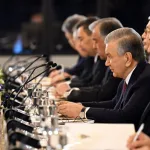Kazakhstan’s recent decision to join the Abraham Accords may represent the start of a transformation, not only for Israel but for two crucial regions of Eurasia.
During the Cold War, America and its allies applied a successful containment strategy to prevent the spread of communism and stabilise the Eurasian continent. Today America, again with its allies—first the EU but not only—appears to be choosing the same strategy to prevent the spread of authoritarianism by the two imperialistic regimes of Eurasia: Russia and China.
Important countries on the peripheries of these two great powers are strengthening their relationships with America, the EU and the democratic West, especially in Central Asia. Kazakhstan’s recent announcement that it will join the Abraham Accords with Israel comes as a surprise to some analysts, but not to those who understand geopolitics and its long-term strategic effects. The rapprochement between the Islamic moderate world and the West is functional not only for stabilising the international system but also for avoiding the meddling of Eurasian dictatorships.
Stabilisation of Eurasia
There are two fundamental regions for the stabilisation of the Eurasian continent and the containment of Russian-Chinese expansion of their spheres of influence. Both could be supported in their process of ‘turning towards the West’ through regional integration, both within and between them: Central Asia (crucial for the Heartland) and Southwest Asia (crucial for the Rimland).
Both regions share common cultures (Turkic-Muslim in the first, Arab-Persian-Muslim in the second), common geography and common history. But whilst the first is already on that path of regional integration, with the advancements of the Organisation of Turkic States and generally with the process of alliance through the Middle Corridor, the second is still in the making. The Abraham Accords were halted by the October 7 attacks, and the IMEC (India Middle East Europe Corridor) remains just a plan.
But Kazakhstan’s decision to join the Abraham Accords—as the fifth country to sign them—in a bid to build momentum for a normalisation framework with Israel, demonstrates that the two regions are more interconnected than commonly assumed. America, which facilitated this agreement during President Kassym-Jomart Tokayev’s visit to Washington, was already supporting the integration of Central Asia through the visionary C5+1 format. After a decade, this initiative increasingly aims towards crucial minerals cooperation. Now, with this development, the link between the two regions grows increasingly evident and could expand further.
The EU already maintains a strong relationship with Central Asia, but this could become more extensive. The same applies to Southwest Asia, particularly considering that Turkey is in NATO and the Gulf Cooperation Council has maintained a cooperation agreement with the EU for some time—though again, this could be expanded considerably.
Now is the moment for the West to support the stabilisation of these two regions before contemplating how to deploy them as corridors connecting the rest of South and East Asia. The aim should be to support a grand bargain amongst the regional powers, particularly in Southwest Asia. A grand bargain between Saudi Arabia, Turkey and Egypt could complete the Abrahamic accords between these countries and Israel. This would not only accelerate the peace process in Gaza but also support regional stabilisation. It might even help the Iranian people rid themselves of the Ayatollahs’ medieval theocracy, providing space for a democratic renaissance in Persia.
Economic growth and regional security
Ultimately, Kazakhstan’s signing of the Abraham Accords could represent, as US special envoy Steve Witkoff stated, the start of an “alliance for Arab-Muslim ties with Israel” with a pro-West coalition of moderate Muslim countries looking for tolerance and prosperity. Many effects could follow from expanding the Abraham Accords to Central Asia and Southwest Asia, provided there is a visionary strategy for the future of the Eurasian continent.
Supporting the integration and pacification of these two crucial regions would bring both economic growth and regional security—development and security advance together—whilst helping them avoid foreign interference. The regions could benefit from Europe’s lesson, consistent across two millennia: avoid foreign interference before corridors; build unions instead.
After Russia’s invasion of Ukraine and China’s creation of the ‘Axis of Upheaval’, the tide may finally be turning. Other countries should seize the momentum and sign the Abraham Accords with Israel, whilst strengthening their relationships with the EU and America. The first could be Saudi Arabia, with Crown Prince Mohammed bin Salman due to visit the White House this month.
Photo: Dreamstime.







